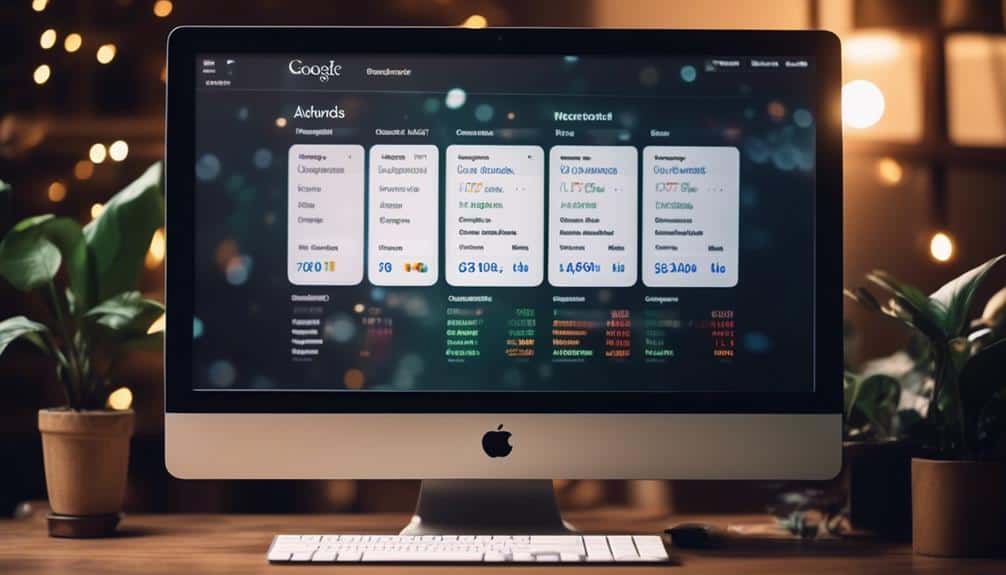PPC Advertising 101: Unlocking the Basics of Pay-Per-Click Success
Imagine you're a captain steering a ship through uncharted waters. Your compass in this digital sea is PPC advertising, a powerful tool that can propel your business towards success. Just like adjusting your sails to catch the wind, mastering the basics of pay-per-click can guide your campaigns to reach new horizons.
But how do you navigate these waters effectively? Let's uncover the essential strategies that can help you avoid getting lost at sea and instead set sail towards a destination of PPC success.
Key Takeaways
- Strategic ad placement is crucial for performance
- Crafting concise ad content with emotional appeal is effective
- Continuously optimizing campaigns based on key metrics is essential
- Smart budget allocation and effective bidding strategies maximize ROI
Understanding PPC Advertising Fundamentals

To master the essence of PPC advertising, you must grasp the fundamental principles that govern its success. Ad placement is a critical aspect of PPC campaigns. Strategic positioning of your ads can significantly impact their performance. By placing your ads where they're most likely to be seen by your target audience, you can increase visibility and drive more traffic to your website.
Click-through rates (CTR) play a vital role in measuring the effectiveness of your PPC ads. A high CTR indicates that your ads are resonating with users and attracting clicks. Monitoring and optimizing your CTR can help improve the overall performance of your campaigns. Experiment with different ad placements and ad copies to enhance your CTR and drive more conversions.
Understanding the relationship between ad placement and click-through rates is essential for maximizing the success of your PPC advertising efforts. By strategically placing your ads and optimizing for higher CTR, you can increase your chances of reaching your target audience and achieving your campaign objectives.
Targeting the Right Keywords
Mastering the essence of PPC advertising involves strategically targeting the right keywords to maximize visibility and drive relevant traffic to your website. Conducting thorough keyword research is essential in identifying the terms and phrases that your potential customers are using in search engines. By understanding search intent – whether it's informational, navigational, or transactional – you can tailor your keyword selection to align with what users are seeking.
Keyword research tools like Google Keyword Planner, SEMrush, or Moz Keyword Explorer can provide valuable insights into search volume, competition levels, and potential traffic. Leveraging these tools allows you to refine your keyword strategy and focus on terms that aren't only relevant to your business but also likely to attract the right audience.
Creating Compelling Ad Copy

Crafting compelling ad copy is crucial in capturing the attention of your target audience and driving them to take the desired action on your website. To create ad copy that resonates with your audience, consider the following ad copywriting techniques:
- Be Concise: Use clear and concise language to convey your message effectively in a limited space.
- Highlight Benefits: Focus on the benefits your product or service offers to the audience rather than just listing features.
- Include a Call-to-Action: Encourage users to take action by including a strong and clear call-to-action in your ad copy.
- Utilize Emotional Appeal: Tap into the emotions of your audience by using language that evokes feelings of joy, fear, excitement, or urgency.
Setting Up Effective Ad Campaigns
When aiming to maximize the impact of your PPC advertising efforts, the key lies in structuring and implementing effective ad campaigns that resonate with your target audience. To achieve this, focus on ad campaign optimization and A/B testing strategies.
Ad campaign optimization involves continuously refining your campaigns to enhance performance. Start by identifying your campaign objectives, selecting relevant keywords, and crafting compelling ad copy. Monitor key metrics like click-through rates and conversion rates to make data-driven decisions for optimization.
A/B testing strategies are essential for fine-tuning your ad campaigns. Create variations of your ads to test different elements such as headlines, calls to action, or visuals. Run these variations simultaneously to compare their performance and identify which resonates best with your audience. By systematically testing and analyzing the results, you can iteratively improve your campaigns over time.
Implementing ad campaign optimization and A/B testing strategies will help you refine your PPC efforts, increase engagement, and drive better results. Stay proactive in monitoring and adjusting your campaigns to stay ahead of the competition and continuously improve your advertising effectiveness.
Monitoring and Analyzing Performance Metrics

As you delve into the realm of PPC advertising, the points to focus on revolve around Key Performance Indicators, Data-Driven Decision Making, and Continuous Improvement Strategies.
These metrics provide valuable insights into the effectiveness of your campaigns, guiding you to make informed decisions and optimize your advertising efforts.
Key Performance Indicators
Monitoring and analyzing performance metrics is crucial for optimizing the effectiveness of your PPC advertising campaigns. By focusing on Key Performance Indicators (KPIs), you can better understand the impact of your efforts and make data-driven decisions to enhance performance.
Here are four essential KPIs to monitor:
- Conversion Tracking: Measure the actions users take after clicking on your ad to gauge the success of your campaign.
- Click-Through Rates: Analyze the percentage of users who click on your ad compared to the total number of impressions.
- Cost Per Acquisition (CPA): Calculate the average cost incurred to acquire a new customer through PPC.
- Return on Investment (ROI): Evaluate the profitability of your PPC campaigns by comparing the revenue generated to the cost of advertising.
Keep a close eye on these KPIs to drive success in your PPC endeavors.
Data-Driven Decision Making
Harnessing the power of data to drive strategic decision-making is essential in optimizing the performance of your PPC advertising campaigns. By delving into data analysis and strategic planning, you can uncover valuable insights that will guide your campaign towards success. Monitoring and analyzing performance metrics is not just a task but rather a strategic approach to ensure your advertising efforts are yielding the desired results. Below is a table illustrating key performance metrics that you should track and analyze to make informed decisions that will enhance the effectiveness of your PPC campaigns:
| Metric | Description | Importance |
|---|---|---|
| Click-Through Rate | Percentage of users who click on your ad | Measure of Ad Relevance |
| Conversion Rate | Percentage of clicks that lead to a desired action | Indicates Ad Effectiveness |
| Cost Per Click | Average cost paid for each click | Determines Cost-Efficiency |
| Quality Score | Google's rating of the quality and relevance of your keywords and PPC campaigns | Influences Ad Ranking |
| Return on Ad Spend | Revenue generated per dollar spent on advertising | Measures Campaign Profitability |
Continuous Improvement Strategies
To drive ongoing success in your PPC advertising campaigns, it's imperative to continuously refine your strategies by closely monitoring and analyzing key performance metrics. By implementing the following strategies, you can ensure your campaigns stay optimized and effective:
- A/B Testing Strategies: Experiment with different ad copies, keywords, and landing pages to identify what resonates best with your audience.
- Conversion Rate Optimization: Focus on improving the percentage of visitors who take the desired action on your website.
- Click-Through Rates: Monitor and enhance your CTR to maximize the number of clicks on your ads.
- Ad Performance Tracking: Keep a close eye on how each ad is performing to allocate budget effectively and make data-driven decisions for future optimizations.
Continuous improvement is key to staying ahead in the dynamic world of PPC advertising.
Optimizing Landing Pages for Conversions

When optimizing landing pages for conversions, focus on clear and compelling messaging to drive action from your visitors. Your landing page design plays a crucial role in user experience and conversion optimization. A well-designed landing page can significantly impact your PPC campaign's success. Utilize A/B testing to experiment with different elements and determine what resonates best with your audience. Ensure your landing page is user-friendly and provides a seamless journey for visitors from click to conversion.
To help you visualize the key components of optimizing landing pages, here is a breakdown in a structured table:
| Landing Page Optimization Strategies | Description | Benefits |
|---|---|---|
| Clear Call-to-Action | Direct and compelling action for users | Increased conversion rates |
| Engaging Visuals | Eye-catching images or videos | Higher user engagement |
| Consistent Messaging | Align with ad copy for continuity | Improved user experience |
| Mobile Responsiveness | Optimized for mobile devices | Reach wider audience |
| Loading Speed Optimization | Fast loading times | Decreased bounce rates |
Budgeting and Bidding Strategies
When it comes to PPC advertising, understanding smart budget allocation and effective bid tactics is crucial for success.
By strategically allocating your budget and employing effective bidding strategies, you can maximize your ROI and reach your target audience more efficiently.
These key points will help you optimize your PPC campaigns and achieve your advertising goals.
Smart Budget Allocation
Smart budget allocation in PPC advertising involves strategic planning and precise bidding strategies to maximize your ROI effectively. To ensure your budget is allocated wisely, consider the following:
- Budget Optimization: Regularly review and adjust your budget allocation based on the performance of your campaigns.
- Performance Tracking: Utilize tracking tools to monitor the performance of your ads and adjust your budget allocation accordingly.
- Strategic Bidding: Employ strategic bidding techniques to optimize your ad placements and bids.
- Cost-Effective Tactics: Implement cost-effective tactics such as long-tail keywords and ad scheduling to make the most of your budget.
Effective Bid Tactics
Implementing effective bid tactics in PPC advertising requires a thorough understanding of budgeting and strategic bidding strategies to optimize campaign performance and drive maximum ROI. To excel in bid optimization, it's crucial to analyze data continuously, adjust bids based on performance, and leverage automation tools to streamline the process. When considering ad placement, focus on targeting high-converting keywords and strategically placing bids to secure prime positions on SERPs. Balancing bid amounts with keyword competitiveness is key to maximizing visibility and clicks while controlling costs. Remember, staying agile and adapting bidding strategies based on real-time data insights is fundamental to achieving success in PPC campaigns.
| Bid Optimization | Ad Placement |
|---|---|
| Continuous Analysis | High-Converting Keywords |
| Data-Driven Decisions | Strategic Bid Placement |
| Automation Tools | Prime SERP Positions |
Implementing Remarketing Tactics

To enhance your PPC campaign's performance and increase conversions, incorporating effective remarketing tactics is essential. Remarketing allows you to target users who've previously interacted with your website or ads, keeping your brand top of mind and encouraging them to return and convert.
Here are four key strategies to implement for successful remarketing:
- Customer Segmentation: Divide your audience into specific segments based on their behavior, interests, or demographics. This allows you to tailor your remarketing ads to each group's preferences, increasing the likelihood of engagement.
- Dynamic Content: Personalize your ads with dynamic content that changes based on the user's past interactions. This customization can significantly improve click-through rates and conversions.
- Cross-Device Remarketing: Reach users on various devices they use by implementing cross-device remarketing strategies. This ensures consistent exposure and engagement across multiple platforms.
- Frequency Capping: Avoid overwhelming users with excessive ad exposure by setting frequency caps. This helps maintain a balance between staying visible and avoiding ad fatigue.
Frequently Asked Questions
How Can I Effectively Split Test My Ad Copy to Improve Performance?
To effectively split test your ad copy, focus on crafting compelling variations using different ad testing strategies. Experiment with various copywriting techniques to enhance performance by analyzing data and refining your messaging for better results.
What Are Some Common Pitfalls to Avoid When Setting up a PPC Ad Campaign?
When setting up a PPC ad campaign, avoid common pitfalls like neglecting negative keywords for precision, managing budgets diligently for efficiency, utilizing ad extensions for enhanced visibility, and scheduling ads strategically for optimal reach and engagement.
How Can I Leverage Audience Segmentation to Improve Targeting in My Campaigns?
To enhance your targeting, leverage audience segmentation through demographic and behavioral targeting. Create custom audiences for tailored messages, and use lookalike audiences to reach new prospects based on similarities to existing customers.
What Are Some Advanced Strategies for Optimizing Landing Pages for Conversions?
To boost conversion rates, focus on mobile optimization and A/B testing. Enhance visual hierarchy to guide users effectively. Strategically place call-to-action buttons for maximum impact. These advanced techniques can elevate your landing page performance significantly.
How Can I Effectively Track and Attribute Conversions Across Different Channels in My PPC Campaigns?
To effectively track and attribute conversions across channels in your PPC campaigns, implement cross-channel tracking and attribution modeling. Utilize conversion tracking and multi-channel attribution to gain insights into user behavior and optimize your marketing strategies for success.
Conclusion
You've now mastered the essentials of PPC advertising. By targeting the right keywords, creating compelling ad copy, and setting up effective campaigns, you're on your way to pay-per-click success.
Remember to monitor performance metrics, optimize landing pages, and implement remarketing tactics to maximize your results.
With strategic budgeting and bidding strategies, you'll continue to refine your approach and drive conversions.
Keep up the great work and watch your pay-per-click efforts flourish!








